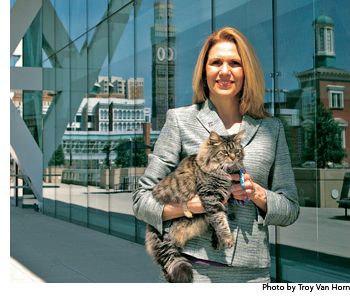Women leading change: Jane Brunt
CATalyst Council director fights for feline health.
< Back | Next >

When the American Veterinary Medical Association announced in 2007 that cats were taken to veterinarians 50 percent less often than dogs, Dr. Jane Brunt was neither happy nor surprised.
“So many pet owners rely on misperceptions: Cats are independent, cats don’t need as much medical care, cats don’t look sick so they’re not sick,” Dr. Brunt says. “We knew we needed to educate veterinarians and the public about what healthcare cats need and deserve.”
So Dr. Brunt and other feline-focused people organized the CATalyst Summit in 2008 to bring together veterinarians, industry representatives, animal-welfare leaders, and other concerned stakeholders to discuss how to spread the news that wasn’t new to any of them: Cats were being neglected.
The success of the CATalyst Summit led to the birth of the CATalyst Council, an organization dedicated to raising awareness of cats’ medical needs and seeking ways to leap over the obstacles to feline healthcare: popular myths about medical needs, cats’ averseness to veterinary visits, and a profession-wide underemphasis on feline wellness in comparison with canine care. Challenges and disparities in cat adoption are also addressed by the council.
“We just kept moving forward, making one change, identifying more needs, and continuing to collaborate,” says Dr. Brunt, the council’s executive director.
Dr. Brunt has been out front in feline health for years, having opened the first feline-only practice in the state of Maryland and speaking at engagements nationwide about improving feline healthcare. While she sees CATalyst as a conduit for change by working with others, she credits the American Association of Feline Practitioners (AAFP) and the American Animal Hospital Association (AAHA) for their leadership in feline medicine through the pain management guidelines and the recently released feline life-stage guidelines. Both are joint AAFP and AAHA efforts. The AVMA and the Society of Animal Welfare Administrations have also embraced opportunities to promote feline health and welfare, working as “CATAlystas” to improve the stature of cats, Brunt says.
The data in 2007 may have been dismal, but Dr. Brunt is optimistic about the future. “Cats will get the care that dogs get,” she says. “Once you bring cats’ needs to the attention of veterinarians and owners, a light goes on. People are watchful once they know the reasons for cats’ behavior and how well they hide pain and illness.”
< Back | Next >